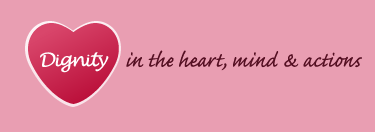Everybody matters 2: promoting dignity in acute care through effective communication
This article encourages dignity champions either working in, or accessing, a care environment to consider how working practice of the medical staff can encourage and enhance the understanding of dignity and need in the people that are cared for within the environment.
This article from the Nursing Times examines the idea that creating community may not be nurses' first thought when thinking about dignity. However, the authors suggest that to move beyond just doing things to people, the idea of a two way relationship is important. To be human we all need connection and communication, particularly in times of uncertainty and vulnerability. Although it varies between individuals, being a hospital patient creates an unbalancing of the emotional, spiritual and social aspects of every person, as well as a physical difficulty. To deliver dignified care, the authors conclude that it is essential that nurses recognise and connect with patients who are in this position.
The authors agree that defining "caring" is not easy and that the potential varies according to patient circumstances but always involves an intention of will, what Iles calls "courage", by the healthcare professional to risk connection with, and on behalf of, the people they are caring for.
The article includes quotes, such as the following one from a student nurse interviewed by the project:- "I have learnt [from the project] to talk to patients; even though they're not in a state of understanding or they're confused, or as you would label them [have] dementia, it doesn't mean that they don't understand. We still treat them the same as any other patient who is less confused. Ask them, gain consent from them before we do anything, bathing them, like Lily, she stops screaming, you know, when you ask her and explain about washing instead of just doing it to her. Yesterday we did that and she laughed with us, it's not always like that but sometimes [it is]."
Another staff member comments:- "I feel valued when I am consulted and asked rather than told to do something. It's about working as a team and understanding that we are all human!"
The authors comment that it can be interesting to turn things on their head and think about what you as a nurse receive from the people for whom you care. Appreciating what people give you may be as simple as recognising a thank you or a patient's smile; it may be a mutual interest that you share with patients or something they give you through their stories and conversation. Finding your way to those connections is the focus of this article.
Some practical suggestions that have emerged from talking to and working with nurses on the wards, such as:-
- Connecting with and creating values around caring;
- Putting yourself in another's shoes;
- Promoting communication that connects with the person.
The authors of this project have worked keenly with staff consultation, drawing on the stories and experience of people working on the wards and in care homes. They have found that having empathy - seeing and feeling the situation from the other's unique perspective - is a key part of giving dignified care. What did become clear from project interviews was the impact on nurses and their care as a result of being on the other side, as a patient or relative: "Since my mum was ill it is different, I see her in other patients, I want to check out that they are OK, that's what I wanted for her."
It was noted that appreciation, of yourself as well as the people around you can get lost in the busy ward culture. Yet being thankful is a skill and needs to be practised like any other. Some ward leaders intentionally end the shift by thanking their staff, while others highlight to their ward team the letters of thanks from patients and family. It was found that focusing on what the ward is doing well is a powerful tool in keeping people connected to each other and to their jobs, with communication noted as another powerful and reqwarding tool.
In conclusion, the authors of the report noted that phrase "walk a mile in another man's shoes" suggests it is not really possible to connect with someone unless you spend some time thinking about their situation or life - metaphorically, putting on their shoes. The challenge in "connect with me" is to move beyond clinical-patient contact to human-human contact. This article provides practical examples to help nurses connect with the people they are caring for and working with. This is rewarding but can be difficult work and the complexities of busy hospitals, with many different people providing care, can challenge sustained human connection.
